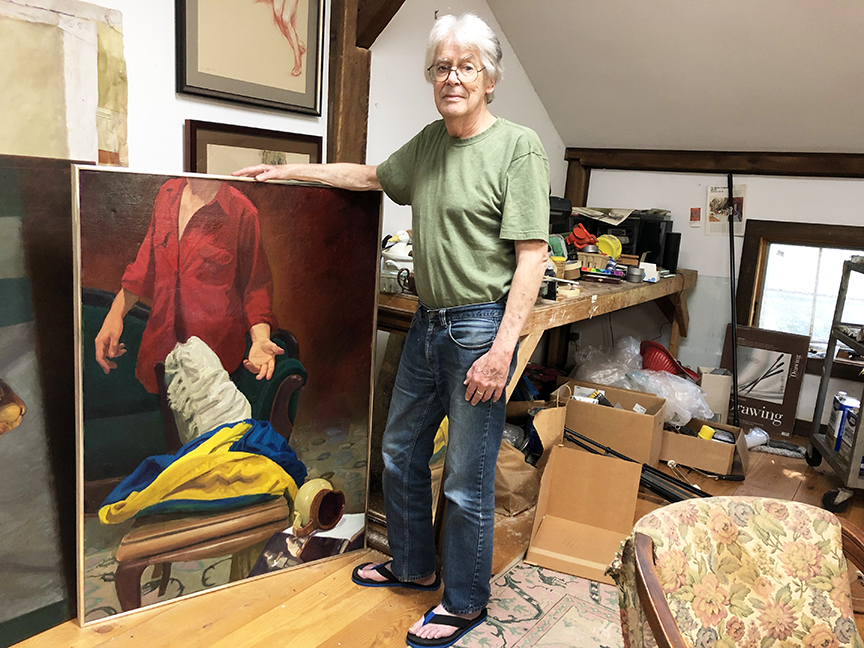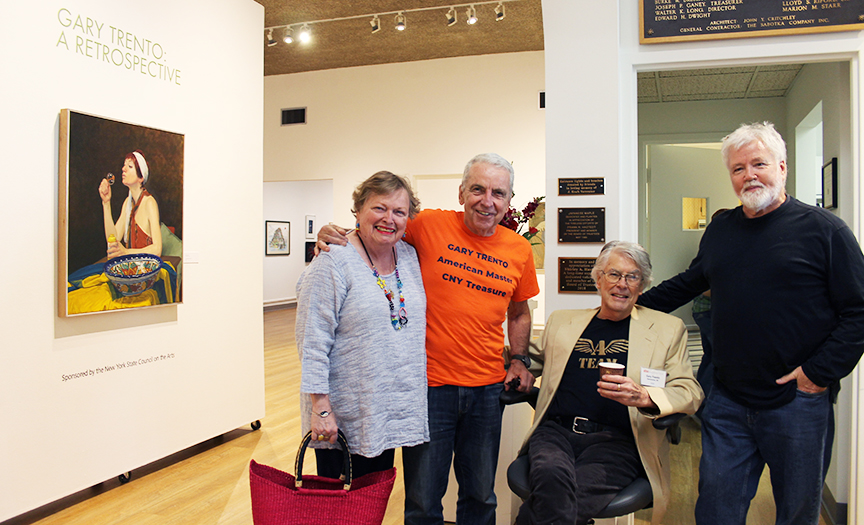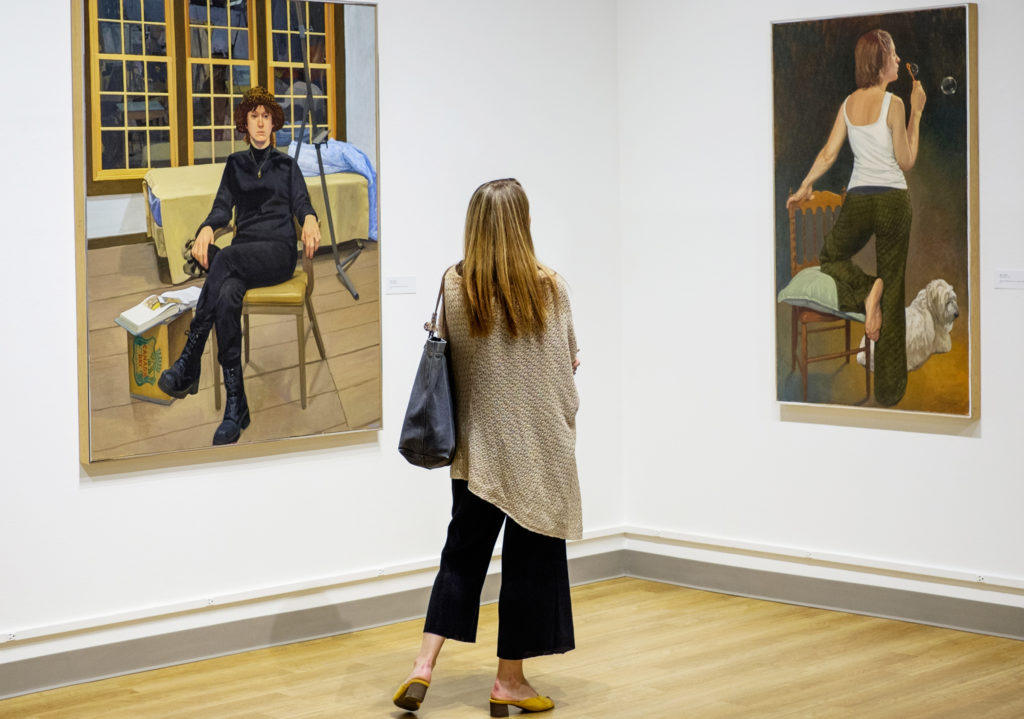Fall exhibits feature retrospective of Gary Trento’s paintings

It’s appropriate on this day, with a slight crisp in the air as the late July afternoon turns into evening, that Gary Trento discusses his upcoming retrospective at the Schweinfurth Art Center in Auburn. His show is the centerpiece of the art center’s three fall exhibits.
Trento’s paintings represent objects or events in the real world, usually easily recognizable. He is known for his realistic portraits, life-size paintings of clothed and unclothed models, and, in more recent years, still lifes.
“I am an artist who paints from life,” he says in his artist’s statement. “This means I always paint with the model or setup before me. I have always believed in the persuasiveness of how this manner of painting can transform the activity of direct observation of the objects in real time and space into a meaningful experience for the viewer without the need of overt social, personal, or political implications.”
The Schweinfurth show, “Gary Trento: A Retrospective,” will run Aug. 30 to Oct. 12, 2019, and feature 23 of his favorite paintings. Completed between 1967 and today, the paintings offer a true retrospective of Trento’s artwork.

Trento was born in Syracuse, the child of a father who was attending Syracuse University. The family moved to New Jersey when Trento was young, and as a teenager he took art lessons from a woman who was well known for her paintings of Maine’s rocky shoreline.
He earned a bachelor’s degree in fine arts from the University of Virginia, where he developed his interest in representational artwork while taking a class in art history. “Cezanne opened my eyes,” Trento said. “The history is as important as the painting. The evolution of my painting is tied to my study of the evolution of painting conventions.”
He then earned his master of fine arts degree at Pratt Institute in the mid-1960s, where he was the only student in the program who painted realistically. “Pop art came in then, and that really took off,” he recalled. “I didn’t have a lot of support from my instructors, but they left me alone.”
It’s not that he doesn’t like abstract art, Trento says, but representational art is what he loves. “I have great appreciation for abstract art, but you have so much room to change your mind. You don’t have to deal with the issues of gravity, of likeness.”
Yes, gravity. He points out that it’s very difficult for models to hold a pose for three straight hours, especially if an arm is being held in the air.
After graduating from Pratt, Trento was offered a job teaching at Syracuse University’s College of Visual and Performing Arts, where he stayed until retiring in 2005 after 39 years. He and his wife – Jill, a fiber artist – live in Skaneateles, where they converted a horse barn into a two-story studio with a floor for each of them.
Trento’s upstairs studio is lined with huge canvases of life-size paintings, mostly of models in various poses with objects and the occasional dog around them. More recently he has painted still lifes, since he stopped hiring models after he retired.
The studio looks lived in, with a row of paint tubes lined on one table, equipment and objects filling a work bench nearby, and a jumble of easels gathered in the center of the room. A small stereo is covered with a stack of CDs and a newspaper laying on top.

Trento said it was hard to settle on just 23 paintings for his show. “That left out a lot of paintings, and a few periods aren’t represented,” he said. “I’ve been painting since 1967.”
He said it sometimes takes years to finish a painting. The size of his work has something to do with that. “At this scale, the decision to make chromatic changes is much different than for a small painting,” he said. “It’s a multiplicity of decisions. To paint the top of a head in a small painting, it’s just a few strokes. At this scale, its hundreds and hundreds of strokes.”
It’s a skill that many lack in the current fast-paced, cellphone camera/video game world we live in, Trento said, adding that representational painting might be a dying art. “Everybody’s an artist today, based on a glimpse,” he said. “People don’t spend time on it. You’ve looked at it but not really seen it.”
Trento points out his favorite painting, “Self-Portrait Without a Head.” He appears in the piece, reaching out with one hand past a piece of furniture that holds a pillow and some clothing, with an open book on the floor in front and a brown and beige pitcher lying on its side.
He began painting it in 1983, restarted it two or three times, and just finished the painting this year. “There’s something melancholy about it,” he said. “I’m reaching out, presenting or explaining something, and objects have fallen over and come to rest in front. There’s a finality about it that I like.”
Also at his scale, Trento becomes part of the painting. “I become one with the painting and one with the people in the painting,” he said. “I’m making their presence important. I try to elevate the items or people in the painting, so viewers will see more than their presence in the piece.”
He notes that his paintings are so large, a viewer cannot really see them all at once like they can with small paintings. And that is part of why he paints so large. “I would hope that people (coming to the show) could participate in the artwork and see what I see,” he said. “They’ll have to stop, to slow down and look at the art, to take time with it.”
– – – – – –
Gary Trento died Sept. 5, 2019, just days after attending the opening of his retrospective.
If you go…
What: “Gray Trento: A Retrospective”
Who: Skaneateles artist Gary Trento
When: Aug. 30 through Oct. 12, 2019
Where: Schweinfurth Art Center, 205 Genesee St., Auburn
Admission: $7 for adults; free for members and children 12 and under
Hours: 10 a.m. to 5 p.m. Tuesdays through Saturdays and 1 to 5 p.m. Sundays
Opening: 5 to 8 p.m. Friday, Aug. 30, 2019; event is free
Also showing: “Member Show 2019” and “The Experience of a Place: Plein Air Landscapes”
